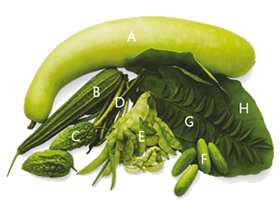Indian vegetables - Īniana huawhenua
The range of Indian vegetables commercially available in New Zealand is increasing.
Varieties
A. Indian Marrow (Lauki or white gourd)
This is a light green marrow that can grow up to a metre. The marrow is peeled and the skin removed. It may be rolled into balls or diced and cooked with split peas or dhal in a curry.
B. Ribbed gourd (Turia)
Peel and cut into chunks to use in a curry. Seeds may or may not be removed.
C. Bitter melon (Karela, fu quas)
Bitter melon is a tropical plant and the fruit has an extremely bitter taste, which is due to the presence of a non-toxic substance. To use, do not peel. Cut the fruit in half and remove the seeds. Thinly slice the flesh, place in muslin, and squeeze the juice out and discard. The flesh is then made into a curry. To remove some of the bitterness blanch in boiling water, or salt for 15 minutes and rinse prior to cooking. Bitter melons can be stuffed with a vegetable or meat filling or sliced finely and stir fried with curry powder until dry and crisp. Bitter melons are also used in Chinese cooking – a traditional Cantonese dish is to stir fry sliced bitter melon with beef and serve it in black bean sauce.
D. Snake beans
Snake beans are the same species as cow peas (chori), but a different subspecies. They are generally eaten as an immature pod. Distantly related to the common bean, harvested when 30−50 cm long, it is used in a similar way, rather than for its seeds. Some snake beans have green seeds and some red. They are usually sliced, and added with tomatoes and spices to make curries.
E. Indian beans (Papri)
There are many different varieties of beans. Most are shelled and used either on their own or in a curry with vegetables, such as onion, tomato, and eggplant. Some varieties are smaller and more tender; with these the whole pod is used – similar to using snow peas. Generally these small papri are curried, often with potato or kumara.
F. Tindori (Galora)
This looks a lot like a gherkin. It is usually sliced lengthwise and added to curries. Cook slowly until tender; it cannot be eaten raw.
G. Curry leaves
Used for flavouring in all Indian cookery. The leaves are used whole and can be dried like a bay leaf. Curry leaves have a citrus-like smell and taste. It is an important flavouring in Asian cuisines. Leaves can be used in dishes and removed before the food is eaten, or used ground or crushed. Curry leaves have been an important folk medicine in China and other Asian countries for centuries.
H. Taro leaves
There are two varieties of Indian Taro leaves – red stemmed and green stemmed. Pacific Island Taro has larger leaves and is widely used in Pacific Island cuisine, often with coconut milk. Tender taro leaves are used in Indian cookery. A paste is made of pea flour, chilli, garlic, lemon juice, garam marsala and water, then spread over washed and dried leaves and then folded into small packages. Older leaves need to be steamed first. The packages are then slowly cooked in a little oil. Once tender they are sprinkled with coconut, green coriander and sugar and served hot or cold. Taro leaves are also used to make a Fijian Indian dish called palusami.
Cow peas (Chori)
These are 12-15 cm in length and only the beans are used, not the pod. There are several varieties available and the colour varies from red, white to green. They are used in soups, stir fries and curries. When dried they are known as the black eyed bean.
Pigeon peas (Toover)
These look similar to standard green peas, although the colour of the pod may vary from light to dark green depending on the variety. They are usually podded, just like peas, and used to make a curry with potatoes. They are also used like papri. When dried, pigeon peas are used to make dhal.
What to look for
Look for produce that appears crisp and fresh, showing no signs of deterioration.
Availability
Available: February to May
Store
Store in a cool place or in the warmest part of the refrigerator.
Nutrition
The vegetables in this group are quite diverse. They include leafy vegetables, seeds, pods, unusual members of the gourd family and herbs.
Belonging to many different families, they range from low to high energy and similarly from low to high nutrient density. There is little research on their phytonutrient content although many Indian vegetables are sources of carotenoids, in particular Indian beans.
While the ribbed gourd and Indian marrow may not be as nutritionally beneficial as others they are useful in the diet by providing dietary fibre, are low energy and in culinary terms act as a base for stronger tasting ingredients.
The beans and peas are a good source of dietary fibre, contain some protein and carbohydrate, vitamin A (from beta-carotene), B vitamins, potassium and some minerals (iron and calcium). Bitter melon is a good source of vitamin C.
Retailing
Group all the Indian vegetables together. Cross merchandise with curry pastes or poppadums. Customers may not know how to use Indian vegetables, so use the QR code on labels.
Store at 10-12°C with a relative humidity of 90-95%.
Purchase Indian vegetables with the New Zealand GAP logo.
